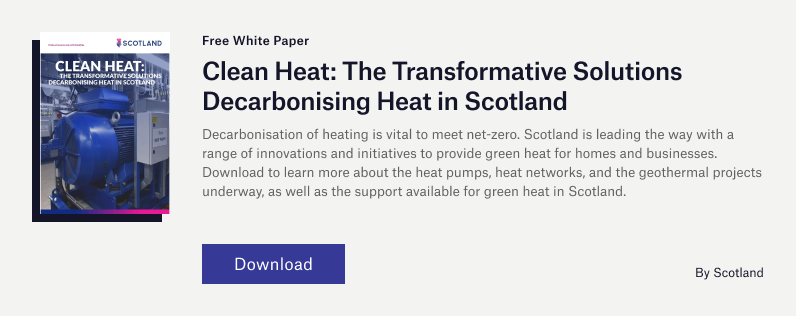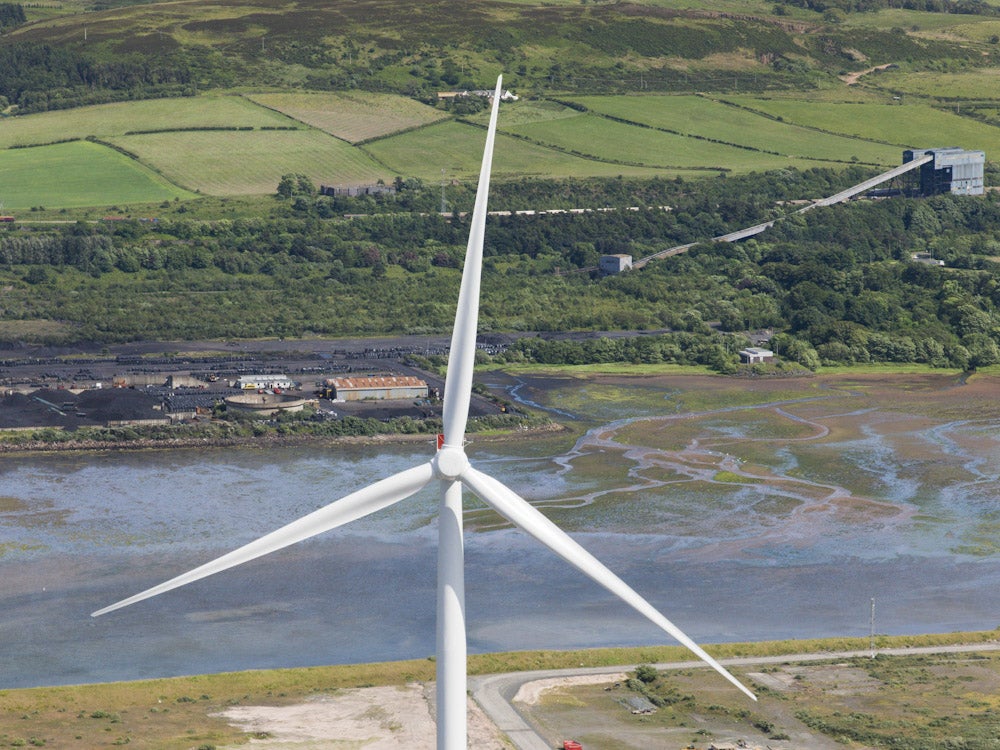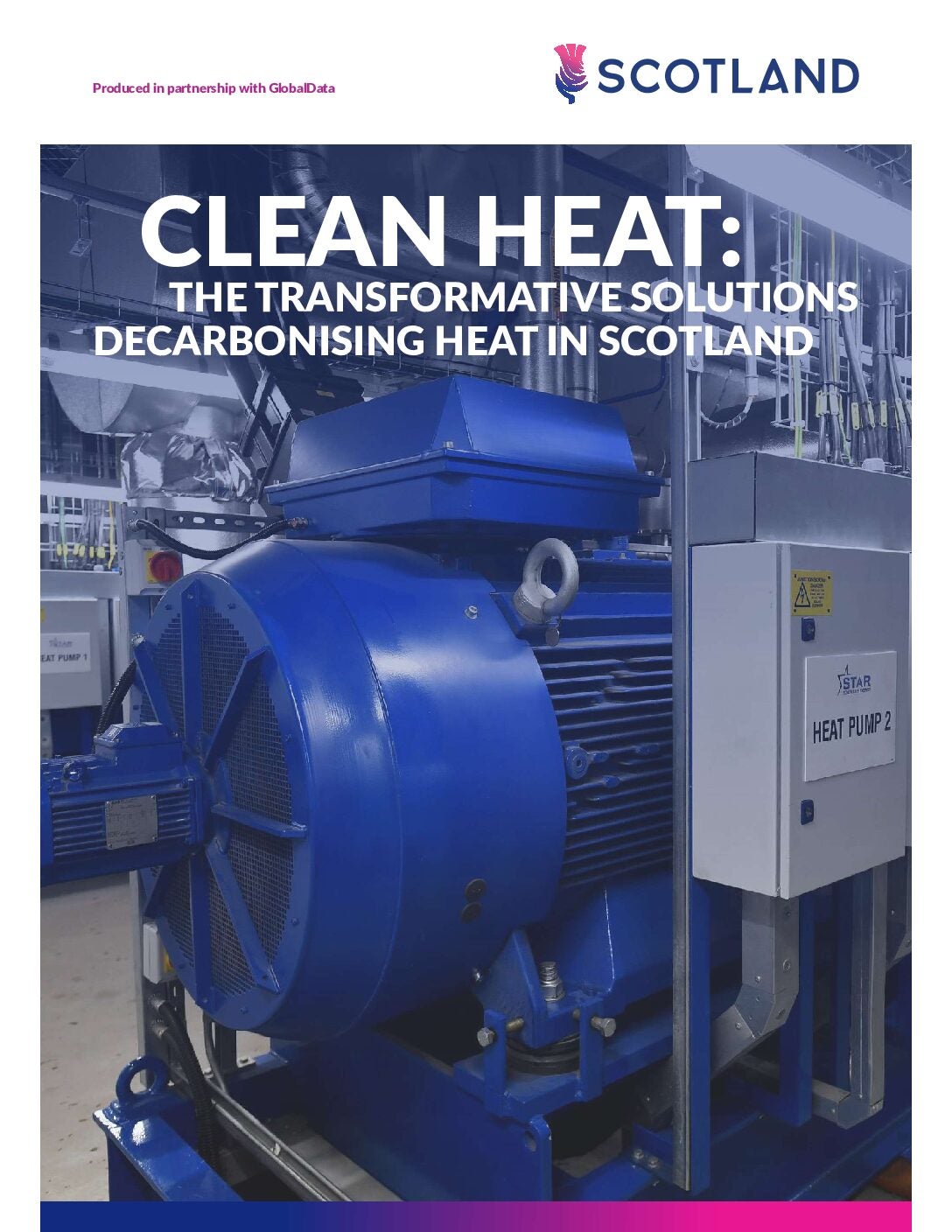
One of the biggest challenges with heating homes from renewable sources is the reliability of energy supplies during different seasons and types of weather – yet geothermal heat has much to offer.
The main misconception about geothermal heat is that it is reliant on steam rising from geysers as famously seen in Iceland. In fact, there are three main sources of geothermal heat – hot rocks, heat from aquifers, and heat from water in abandoned mines. All three have significant potential but heat from water in abandoned mines can be accessed in Scotland’s Midland Valley at shallower depths than other sources of geothermal heat.

Significant progress is being made in the roll-out of heat pumps and scale-up of heat networks to decarbonise heating, but the vast potential of geothermal mine water remains relatively untapped. To harness the dormant assets of flooded mines throughout Scotland, considerable research is under way.
Harnessing geothermal heat sources in Scotland
The mines that were once the heartbeat of Scottish communities could soon make a major contribution to the energy transition through geothermal heat, as well as generating economic and employment opportunities that may not have been present in some towns since the mines closed.
In Scotland, there is a potential 600km3 of disused mine workings available in the Midland Valley. This could theoretically meet 8% of Scotland’s domestic heating requirements and up to 40% of Glasgow’s heat demand. If this potential is realised, it could make Scotland a world leader in the sector.
Research by the Mining Remediation Authority (formerly known as the Coal Authority) suggests that these flooded shafts could hold 7,920 petajoules of untapped heat. For context, natural gas was used to produce 1,080 petajoules to heat UK homes in 2020, according to UK Government data.
Shallow mines with depths down to 200m typically have water temperatures of 10˚C–25˚C. To use this in a heat network, a borehole is used to access mine water. A heat pump extracts the heat and boosts it to the required temperature. Hot water is then circulated to household or business customers for heating, while the cold water is returned to the source for reheating.
Determining the suitability of mine water for geothermal projects
In the UK, most projects exploring disused mine workings will require approval from the Mining Remediation Authority. The Mining Remediation Authority owns the majority of disused coal mines on behalf of the UK Government. The organisation also manages permissions to access its underground properties for projects relating to mine water heating, cooling, storage schemes or research.
A permit from the Mining Remediation Authority is required to drill boreholes and begin an exploration for a project that intersects or occupies their underground property. The main purpose is to manage the risks associated with drilling and understand the effects.
“It’s really important for us to understand that the workings are connected, and data can help to inform that,” says Joanne Eynon, principal manager for mine heat licensing at the Mining Remediation Authority.
“We’re looking for key assurances around mine water chemistry and the hydrogeological balance,” adds Eynon. “We also want to review and manage the potential migration of mine gas and any potential risks that could be identified to ground stability.”
As there are many different factors that vary from one site to the next, each application is reviewed on a case-by-case basis. It must be evident from the applicant how risks can be managed and what operating controls may be required. Given the energy potential in disused mines, the Mining Remediation Authority is working to make the process as efficient as possible.
“If somebody is looking to bring forward a scheme or just wants to understand more, we can have an initial conversation and send some information that can help people to understand before they get into the process,” she adds. “We can let people know what might be required to help facilitate a smoother process and identify upfront timescales to help an applicant identify where funding may be required.”
Using mine water for geothermal energy storage
Flooded mines could also be used to store thermal energy. A persistent issue with wind energy is turning the turbines off when the generation capacity peak is reached. Researchers believe that in East Ayrshire, an estimated 120GW is effectively going to waste from unused wind.
To address this, the STEaM thermal storage project aims to use mine water to thermally store excess wind energy. Described as a giant immersion heater, the project team believe it is possible to establish high-volume storage of thermal energy that is consistent year-round, regardless of the season or weather.
Professor Zoe Shipton from the University of Strathclyde leads the STEaM thermal storage project. Shipton also led the HotScot project, bringing together academics, local government, industry and the social sector to establish Scotland’s abandoned mines as assets.
“We have got holes in the ground. They are big and underneath cities. The question with STEaM is if we fill them with heat and then take it out again multiple times a year, can we do that safely and effectively?” says Shipton.
“We think we can, but we need to do the research to investigate that. STEaM is a research project, but the results should unlock a really exciting opportunity, not just for Scotland but globally.”
Studies of thermal storage in mine workings in Europe are in their early stages and small in scale. STEaM is the first project to explore storage within a shaft rather than lower-volume mine workings.

Reusing heat from the dancefloor
To fully harness the potential of geothermal energy, a range of different innovative projects are underway in Scotland.
Perhaps the most eye-catching project is the BODYHEAT system, which stores heat from people dancing in the SWG3 nightclub in Glasgow. Developed by Scottish geothermal start-up TownRock Energy, heat pumps powered by renewable energy extract heat from the dancefloor and send it for storage in 12 U-shaped boreholes that are 200m underground.
When the energy is needed for heating or cooling, heat is pumped back up to the heat pumps and upgraded to the correct temperature before reuse. The system can even capture heat and use it for cooling during the same event. The project was developed with funding and support from the Scottish Government, the UK Community Renewal Fund, and the William Grant Foundation.
“BODYHEAT at SWG3 is a world first – quick response borehole thermal energy storage for a multi-use arts venue across two buildings,” says David Townsend, founder and CEO of TownRock Energy. “We were developing the technology, as well as fundraising and permitting for three years prior to turn-on, nearly entirely during the height of the Covid pandemic.”
According to Townsend, the success of the project has led to global interest in the concept from a range of different businesses.
“TownRock Energy has received an abundance of enquiries from all over the world thanks to the global media attention over the past few years, not just from venues but also from diverse customers such as data centre operators and farmers,” he adds. “We are working on rolling it out, and some of the main challenges include retrofitting existing buildings, permanency of building use and ownership.”
The rise in data centres and advanced computer systems also present opportunities to reuse the considerable amount of heat they produce. The University of Edinburgh is conducting research in this area. For example, the university’s Advanced Computer Facility (ACF) emits as much as 70GWh of heat a year. Studies are underway to see if it is possible to reuse this excess energy via underground mine networks to reduce the bills for thousands of households. Furthermore, the amount of heat generated at the university could soar to 272GWh upon the potential development of a new supercomputer.
Since 2023, the Scottish Government has been publishing quarterly progress reports on heat network projects supported by Scotland’s Heat Network Fund, Low Carbon Infrastructure Transition Programme, Social Housing Net Zero Heat Fund, and the Heat Network Support Unit. Several of these projects are for ground source heat pumps.
Support for Scottish geothermal projects
Despite the immense potential for geothermal energy, several issues must be resolved before it can be adopted more widely. At present, there remains uncertainty as to who owns geothermal heat. The Scottish Government is ahead of the other nations in drafting legislation around the heating systems that can be used in homes and places of work.
To further the understanding of geothermal processes in Scotland, the British Geological Survey’s Glasgow UK Geoenergy Observatory offers essential research capabilities. The site has a number of boreholes equipped with advanced sensors for testing a range of depths down to more than 90m to study the environmental impact and changes in the chemistry of shallow, low-temperature mine water. Various types of environmental monitoring are available, with open data available for research.
The facility can be used by industry, academia and public sector organisations. Project partnerships are also available. “It is an amazing platform for experimentation, and for validating new products such as sensors,” comments Shipton.
There is also a push in Scotland to make full use of the transferrable skills from the oil and gas industry. Geothermal could benefit greatly from extensive domestic experience in areas such as drilling, corrosion management, underground modelling, and data analytics.
A further useful resource is the Mine Water Geothermal Resource Atlas, an online mapping feature that identifies a total of 370.3km2 of sites in Scotland that are potentially suitable for geothermal mine water developments.
Alongside this, the British Geological Survey coordinates the IEA Mine Water Geothermal Energy Expert Group to share research and enable collaborations to further geothermal innovations. The group brings together a mix of government, business, academia, and regulators. Every year, a Mine Water Energy Symposium is organised by the British Geological Survey, the Mining Remediation Authority, the Department for Energy Security and Net Zero, and IEA Geothermal. This year’s symposium is being held online on 7 and 8 May.
The Scottish Government has worked with the Scottish Environment Protection Agency, the Health and Safety Executive, the Mining Remediation Authority, and the British Geological Survey on the development of regulatory guidance for accessing geothermal resources in Scotland, as well as providing supporting information to raise awareness about the energy potential. In addition, the Waste Heat Recovery Guide was published last year and features mine water heat.
In February 2025, Scottish Enterprise published the report titled Unlocking the Economic Potential of Minewater Geothermal in Scotland. Scottish Enterprise commissioned the report to understand the types of information stakeholders require in the earliest project stages. The report sought to understand the level of awareness surrounding the use of mine water for low-carbon heating.
Funding remains one of the main obstacles for geothermal development and scale-up. To address this in Scotland, a range of potential grants and other types of financial support are available.
Scottish Enterprise can also help companies access funding for green energy projects within Horizon Europe after the UK was readmitted in recent years.
To learn more about the development of Clean Heat in Scotland, download the specially commissioned document below.



